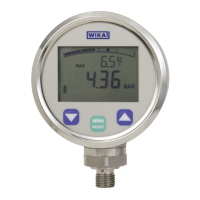
Do you have a question about the WIKA DG-10-S and is the answer not in the manual?
| Brand | WIKA |
|---|---|
| Model | DG-10-S |
| Category | Measuring Instruments |
| Language | English |
Provides contact details, website, and data sheet information for further assistance.
Explains the working principle of the digital pressure gauge and signal conversion.
Details the items included with the digital pressure gauge upon delivery.
Clarifies the meaning of warning, caution, and information symbols used in the manual.
Defines the specific application and purpose for which the digital pressure gauge is designed.
Lists prohibited uses and actions that could lead to hazardous situations or damage.
Specifies the required qualifications and training for personnel handling the instrument.
Provides instructions for checking and reporting any damage incurred during transportation.
Details safety precautions related to residual media during storage of the instrument.
Guides on the correct procedure for physically installing the pressure gauge, including sealing faces.
Details the power source, which is two 1.5 V AA batteries, and expected operating time.
Provides a comprehensive overview of the digital display, its segments, and measurement capabilities.
Details the tare function for measuring relative pressure or zeroing the display.
Explains the functions of the buttons (MENU/ON/OFF, Up, Down) in operating mode.
Describes the procedure for restoring the device to its original factory configuration.
Lists potential causes and solutions for the device not showing any display.
Addresses faults where the display shows zero despite applied pressure.
Details reasons for inaccurate readings or deviations in the signal span.
States that the digital pressure gauge is maintenance-free, with repairs by the manufacturer only.
Provides instructions on how to safely clean the instrument, including suitable agents.
Outlines the procedure for safely removing the pressure gauge from its installation.
Instructs on environmentally compatible disposal methods for the instrument and packaging.
Details the accuracy specifications, including reference conditions and calibration.
Outlines the permissible operating environments, including ingress protection and temperatures.
Lists the materials used for wetted and non-wetted parts of the instrument.
Lists sealing materials and thread size for process connections.